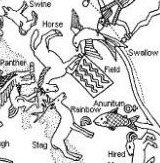186. Once again. The
Babylonian Rainbow was like a bridge
between the Stag and Anunitum:
... The Wing of the Pegasus Horse was where
the Babylonians had their 1-iku
constellation, ruled by Anunitum (τ
Piscium) - and the Wing (Gienah) of
Raven was when in rongorongo times the Sun
reached the southern spring equinox in
September.
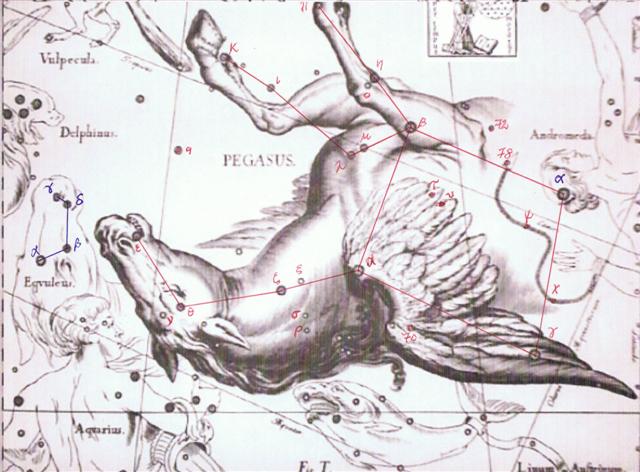

South of the equator the Rainbow
of the Babylonians seems to have
corresponded to a double bow sign at the
rain junction (te ua) where Sky and
Earth lay in primal embrace:
... Sky (rangi) and
Earth (papa) lay in
primal embrace, and in the
cramped, dark space between
them procreated and gave
birth to the gods such as
Tane, Rongo and
Tu. Just as children
fought sleep in the stifling
darkness of a hare paenga,
the gods grew restless
between their parents and
longed for light and
air. The herculean
achievement of forcing Sky
to separate from Earth was
variously performed by
Tane in New Zealand and
the Society Islands, by
Tonofiti in the
Marquesas and by Ru (Tu)
in Cook Islands. After the
sky was raised high above
the earth, props or poles
were erected between them
and light entered,
dispelling the darkness and
bringing renewed life. One
detail which is
iconographically of interest
is whether the god
responsible for separating
Earth and Sky did so by
raising the Sky with his
upraised arms and hands, as
in Tahiti and elsewhere, or
with his feet as in New
Zealand ...
 |
 |
 |
 |
|
Cb2-4 (420 = 285 + 135) |
Cb2-5 (392 + 29) |
Cb2-6 (30) |
Cb2-7 (423) |
|
te ua |
koia ra |
kua tuku ki to
mata - ki tona tukuga |
e kiore - henua
- pa rei |
|
INVISIBLY CLOSE TO THE SUN NORTH
OF THE EQUATOR: |
|
π Cor.
Borealis,
UNUK ELHAIA
(Necks of the Serpents)
= λ Serpentis
(238.1),
CHOW = β Serpentis
(238.6) |
κ
Serpentis
(239.3), δ Cor. Borealis,
TIĀNRŪ = μ Serpentis
(239.5), χ Lupi, (239.6), ω
Serpentis (239.7),
BA = ε Serpentis,
χ Herculis (239.8).
κ
Cor. Borealis,
ρ Serpentis (239.9) |
λ Librae (240.0), β Tr. Austr.
(240.3), κ Tr. Austr. (240.4), ρ
Scorpii (240.8) |
Iklīl al Jabhah-15 (Crown of the
Forehead) /
Anuradha-17
(Following rādhā) /
Room-4 (Hare)
ξ Lupi, λ Cor. Bor.(241.1),
ZHENG = γ Serpentis,
θ Librae (241.2),
VRISCHIKA
= π Scorpii
(241.3), ε Cor. Borealis
(241.5), DSCHUBBA
(Front of Forehead) = δ Scorpii
(241.7), η Lupi (241.9) |
|
Egyptian hand |
 |
Phoenician
kaph |
 |
Greek
kappa |
Κ (κ) |
|
Kaph is
thought to have
been derived
from a pictogram
of a hand (in
both modern
Arabic and
modern Hebrew,
kaph
means palm/grip)
...
... The manik,
with the tzab,
or serpent's
rattles as
prefix, runs
across Madrid
tz. 22 , the
figures in the
pictures all
holding the
rattle; it runs
across the
hunting scenes
of Madrid tz.
61, 62, and
finally appears
in all four
clauses of tz.
175, the
so-called
'baptism'
tzolkin. It
seems
impossible, with
all this, to
avoid assigning
the value of
grasping or
receiving. But
in the final
confirmation, we
have the direct
evidence of the
signs for East
and West. For
the East we have
the glyph
Ahau-Kin,
the Lord Sun,
the Lord of Day;
for the West we
have
Manik-Kin,
exactly
corresponding to
the term
Chikin, the
biting or eating
of the Sun,
seizing it in
the mouth.



The pictures
(from Gates)
show east,
north, west, and
south;
respectively
(the lower two
glyphs) 'Lord'
(Ahau)
and 'grasp' (Manik).
Manik was
the 7th day sign
of the 20 and
Ahau the
last
... |
|
|
Nov 14 |
15 |
16 (320 = 137 + 183) |
17 (*241 = *58 + *183) |
|
ºNov 10 (314) |
11 |
12 |
13 (*237) |
|
'Oct 18 (108 + 183 = 291) |
19 |
20 |
21 (*214 =*31 + *183) |
|
"Oct 4 (277 = 314 - 37) |
5 |
6 |
7 (*200 = *17 + *183) |
|
SEPT 11
(254 = 71 + 183) |
12 (365 - 100) |
13 |
14 (*177 = *354 / 2) |
|
234 = 314 - 80 |
235 |
236 = 320 - 84 |
237 (= 8 * 29½ + 1) |

Kiore. Rat. Vanaga.
Rat, mouse; kiore hiva,
rabbit. P Pau., Mgv.: kiore,
rat, mouse. Mq.: kioē,
íoé, id. Ta.: iore,
id. Churchill. |
|
... All was now ready for
departure except that there was
no fire in the smithy. The
ancestor slipped into the
workshop of the great Nummo, who
are Heaven's smiths, and stole a
piece of the sun in the form of
live embers and white-hot iron.
He seized it by means of a
'robber's stick' the crook of
which ended in a slit, open like
a mouth. He dropped some of the
embers, came back to pick them
up, and fled towards the
granary; but his agitation was
such that he could no longer
find the entrances. He made the
round of it several times before
he found the steps and climbed
onto the flat roof, where he hid
the stolen goods in one of the
skins of the bellows,
exclaiming: 'Gouyo!',
which is to say. 'Stolen!'. The
word is still part of the
language, and means 'granary'.
It is a reminder that without
the fire of the smithy and the
iron of hoes there would be no
crops to store
...
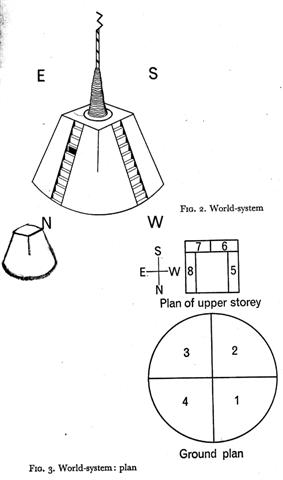
During his descent the ancestor
still possessed the quality of a
water spirit, and his body,
though preserving its human
appearance, owing to its being
that of a regenerated man, was
equipped with four flexible
limbs like serpents after the
pattern of the arms of the Great
Nummo. The ground was rapidly
approaching. The ancestor was
still standing, his arms in
front of him and the hammer and
anvil hanging across his limbs.
The shock of his final impact
on the earth when he came to the
end of the rainbow,
scattered in a cloud of dust the
animals, vegetables and men
disposed on the steps. When calm
was restored, the smith was
still on the roof, standing
erect facing towards the north,
his tools still in the same
position. But in the shock of
landing the hammer and the anvil
had broken his arms and legs at
the level of elbows and knees,
which he did not have before.

He thus acquired the joints
proper to the new human form,
which was to spread over the
earth and to devote itself to
toil
...
 |
|
May 16 (136) |
|
|
CLOSE TO THE FULL MOON
ON EASTER ISLAND: |
|
Al Thurayya-27 (Many Little
Ones) /
Krittikā-3 (Nurses of
Kārttikeya)
/
TAU-ONO
(Six Stones)
ATIKS = ο Persei, RANA (Frog) =
δ Eridani
(55.1),
CELAENO (16 Tauri), ELECTRA
(17), TAYGETA (19),
ν Persei
(55.3),
MAIA (20), ASTEROPE (21), MEROPE
(23)
(55.6) |
Hairy Head-18
(Cockerel) /
Temennu-3
(Foundation Stone)
ALCYONE
(56.1),
PLEIONE
(28 Tauri),
ATLAS
(27)
(56.3) |
MENKHIB = ζ Persei
(57.6)
PORRIMA (γ Virginis)
|
ZAURAK
(The Boat) = γ Eridani
(58.9) |
|
15 (135 + 365 = 500) |
May 16 (136) |
17 |
18 (*58) |
|
ºMay 11 |
12 (132) |
13 |
14 (*54) |
|
4-18 (473
= 108 + 365) |
'April 19 |
4-20 |
21 (111) |
|
"April 4 |
5 (501 - 41 = 460) |
6 (*16) |
7 |
|
MARCH 12 |
13 |
3-14 (73) |
15 |
|
417 (= 501 - 84) |
52 |
53 (= 73 - 20) |
54 (= *58 - 4) |
|
... The Mahabharata
insists on six as the
number of the Pleiades as well
as of the mothers of Skanda
and gives a very broad and wild
description of the birth and the
installation of Kartikeya
'by the assembled gods ... as
their generalissimo', which is
shattering, somehow, driving
home how little one understands
as yet. The least which can be
said, assuredly: Mars was
'installed' during a more or
less close conjunction of all
planets; in Mbh. 9.45 (p. 133)
it is stressed that the powerful
gods assembled 'all poured water
upon Skanda, even as the
gods had poured water on the
head of Varuna, the lord
of waters, for investing him
with dominion'. And this
'investiture' took place at the
beginning of the Krita Yuga,
the Golden Age
... |
|
... They go inland at the land.
The child nursed and tended
grows up, is able to go and
play. Each day he now goes off a
bit further away, moving some
distance away from the house,
and then returns to their house.
So it goes on and the child is
fully grown and goes to play far
away from the place where they
live. He goes over to where some
work is being done by a father
and son. Likāvaka is the
name of the father - a
canoe-builder, while his son is
Kiukava.
Taetagaloa
goes right over there and steps
forward to the stern of the
canoe saying - his words are
these: 'The canoe is crooked.'
(kalo
ki ama).
Instantly Likāvaka is
enraged at the words of the
child. Likāvaka says:
'Who the hell are you to come
and tell me that the canoe is
crooked?'
Taetagaloa
replies: 'Come and stand over
here and see that the canoe is
crooked.' Likāvaka goes
over and stands right at the
place Taetagaloa told him
to at the stern of the canoe.
Looking forward, Taetagaloa
is right, the canoe is crooked.
He slices through all the
lashings of the canoe to
straighten the timbers. He
realigns the timbers. First he
must again position the
supports, then place the timbers
correctly in them, but
Kuikava the son of
Likāvaka goes over and
stands upon one support. His
father Likāvaka rushes
right over and strikes his son
Kuikava with his adze.
Thus Kuikava dies.
Taetagaloa
goes over at once and brings the
son of Likāvaka,
Kuikava, back to life. Then
he again aligns the supports
correctly and helps Likāvaka
in building the canoe. Working
working it is finished
... |
|
... They all sat down and rested
[on the plain of Oromanga],
when suddenly they saw that a
turtle had reached the shore and
had crawled up on the beach. He
[Ira] looked at it and
said, 'Hey, you! The turtle has
come on land!' He said, 'Let's
go! Let's go back to the shore.'
They all went to pick up the
turtle. Ira was the first
one to try to lift the turtle -
but she didn't move. Then
Raparenga said, 'You do not
have the necessary ability. Get
out of my way so that I can have
a try!' Raparenga stepped
up and tried to lift the turtle
- but Raparenga could not
move her. Now you spoke,
Kuukuu: 'You don't have the
necessary ability, but I shall
move this turtle. Get out of my
way!' Kuukuu stepped up,
picked up the turtle, using all
his strength. After he had
lifted the turtle a little bit,
he pushed her up farther. No
sooner had he pushed her up and
lifted her completely off the
ground when she struck Kuukuu
with one fin. She struck
downward and broke Kuukuu's
spine.The turtle got up, went
back into the (sea) water, and
swam away. All the kinsmen spoke
to you (i.e. Kuukuu):
'Even you did not prevail
against the turtle!'
They put the injured Kuukuu
on a stretcher and carried him
inland. They prepared a soft bed
for him in the cave and let him
rest there. They stayed there,
rested, and lamented the
severely injured Kuukuu.
Kuukuu said, 'Promise me,
my friends, that you will not
abandon me!' They all replied,
'We could never abandon
you!' They stayed there
twenty-seven days in Oromanga.
Everytime Kuukuu asked,
'Where are you, friends?' they
immediately replied in one
voice, 'Here we are!' They all
sat down and thought. They had
an idea and Ira spoke,
'Hey, you! Bring the round
stones (from the shore) and pile
them into six heaps of stones!'
One of the youths said to Ira,
'Why do we want heaps of stone?'
Ira replied, 'So that we
can all ask the stones to do
something.' They took (the
material) for the stone heaps (pipi
horeko) and piled up six
heaps of stone at the outer edge
of the cave. Then they all said
to the stone heaps, 'Whenever he
calls, whenever he calls for us,
let your voices rush (to him)
instead of the six (of us)
(i.e., the six stone heaps are
supposed to be substitutes for
the youths). They all drew back
to profit (from the deception)
(? ki honui) and
listened. A short while later,
Kuukuu called. As soon as
he had asked, 'Where are you?'
the voices of the stone heaps
replied, 'Here we are!' All (the
youths) said, 'Hey, you! That
was well done!'
... |
|
... Vainamoinen set about
building a boat, but when it
came to the prow and the stern,
he found he needed three words
in his rune that he did not
know, however he sought for
them. In vain he looked on the
heads of the swallows, on the
necks of the swans, on the backs
of the geese, under the tongues
of the reindeer. He found a
number of words, but not those
he needed. Then he thought of
seeking them in the realm of
Death, Tuonela, but in vain. He
escaped back to the world of the
living only thanks to his potent
magic. He was still missing his
three runes. He was then told by
a shepherd to search in the
mouth of Antero Vipunen, the
giant ogre. The road, he was
told, went over swords and
sharpened axes. Ilmarinen made
shoes, shirt and gloves of iron
for him, but warned him that he
would find the great Vipunen
dead. Nevertheless, the hero
went. The giant lay underground,
and trees grew over his head.
Vainamoinen found his way to the
giant's mouth, and
planted his iron staff in it.
The giant awoke and suddenly
opened his huge mouth.
Vainamoinen slipped into it and
was swallowed. As soon as he
reached the enormous stomach, he
thought of getting out. He built
himself a raft and floated on it
up and down inside the giant.
The giant felt tickled and told
him in many and no uncertain
words where he might go, but he
did not yield any runes. Then
Vainamoinen built a smithy and
began to hammer his iron on an
anvil, torturing the entrails of
Vipunen, who howled out magic
songs to curse him away. But
Vainamoinen said, thank you, he
was very comfortable and would
not go unless he got the secret
words. Then Vipunen at last
unlocked the treasure of his
powerful runes. Many days and
nights he sang, and the sun and
the moon and the waves of the
sea and the waterfalls stood
still to hear him. Vainamoinen
treasured them all and finally
agreed to come out. Vipunen
opened his great jaws, and the
hero issued forth to go and
build his boat at last
...
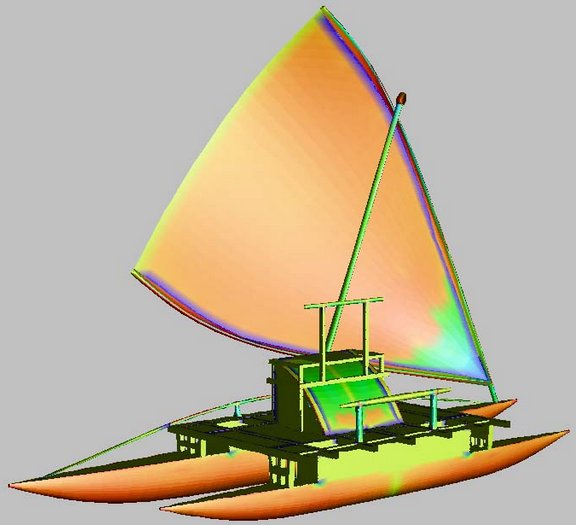 |
Although Metoro said te ua
also at the reversed sign 77 - 28 = 49 (= 7
* 7) days later, where the eye (mata)
born in front clearly ought to have
indicated light was close
ahead:
|
42 |
 |
 |
 |
 |
 |
|
Cb4-3 (466) |
Cb4-4 |
Cb4-5 |
Cb4-6 (77) |
Cb4-7 |
|
te hakaua |
te henua |
te Rei |
te ua |
kiore - henua |
|
INVISIBLY CLOSE TO THE SUN NORTH OF
THE EQUATOR: |
|
(321 + 43 = 364) |
Dec 31 |
Jan 1 |
2 |
3 |
|
CLOSE TO THE FULL MOON
ON EASTER ISLAND: |
|
(138 + 43 = 181) |
July 1 |
2 |
3 |
4 |
The C text could here be read
from a position north of the equator and
then the light of the rainbow would
correspond to the beginning of January or
the text could be read from Easter Island
and then this part of the text would correspond to the
beginning of July.
Counted from Bharani at the
Full Moon in Cb1-14 there were 77 - 14 = 63
days to te ua in Cb4-6:
 |
5 |
 |
 |
 |
 |
|
Cb1-6 (398) |
Cb1-12 (354 + 50) |
Cb1-13 |
Cb1-14 (350 + 8 * 7) |
Cb1-15 (407) |
|
te pahu |
manu rere - kua rere ga manu
- ki te ragi |
eaha te nuku erua |
koia kua huki |
e niu tu |
|
Al Ghafr-13 (Covering) /
Svāti-15
(Very Good)
TAHUA-TAATA-METUA-TE-TUPU-MAVAE
(Pillar to stand by)
ARCTURUS, SYRMA (*215) |
31 Bootis (222.0),
YANG MUN
(South Gate) = α Lupi
(222.1),
RIJL AL AWWA (Foot of the
Barker) = μ Virginis
(222.5), ο Bootis (222.9) |
IZAR (Girdle) = ε Bootis
(223.0),
109 Virginis,
α
Apodis (No Feet)
(223.3), μ Librae (223.8) |
Al Zubānā-14a
/
Visakha-16 (Forked) /
Root-3 (Badger)
ZUBEN
ELGENUBI
(*224) |
KOCHAB
(Kakkab,
the Star) = β Ursae Min.
(225.0), ξ Librae (225.7) |
|
Oct 22 (295) |
Oct 28 (300 + 1) |
29 |
30 (366 - 63) |
31 |
|
AUG 20 (232 = 212 + 20) |
26 (*158 = *222 - *64) |
27 (239) |
28 (180 + 60) |
29 (241 = 58 + 183) |
|
212 (= 29 + 183) |
218 |
219 |
220 |
221 |
|
MIRA (*33 = *215 - 182) |
5 |
μ
Arietis (39.4),
HEAD OF THE FLY
= 35 Arietis
(39.6),
KAFFALJIDHMA = γ Ceti,
θ Persei (39.8) |
π
Ceti, ο Arietis (40.0),
ANGETENAR (Bend in the River) =
τ¹ Eridani,
μ Ceti (40.2),
RIGHT WING = 39 Arietis
(40.9) |
BHARANI (*41 = *224 - 183) |
TA LING (Great Mound)
= τ
Persei (42.4) |
|
April 23 (295 - 182) |
April 29
(118 + 1) |
30 |
May 1 (121) |
2 |
|
'March 27 (*6) |
'April 2 (92 = 91 + 1) |
3 |
4
(*14 = *41 - 27) |
5 |
|
"March 13 (*358) |
"March 19 (*364) |
3-20 (*365) |
0h (*366) |
"March 22 (*1) |
|
FEBR 18 (*335) |
BIS-SEXTUM |
25 (56 = 120 - 64) |
26 (*343 = *366 - 23) |
2-27 |
|
29 |
35 |
36 |
37 = 41 - 4 |
38 = 58 - 20 |
|
394 = 398 - 4 |
400 = 35 + 365 |
401 |
402 |
403 = 407 - 4 |
|
The sequence of heliacal star
dates in the text seems here to
make a jump ahead with 1 place,
because *366 = 365 + 1 and from
Arcturus, Syrma (*215) to Zuben
Elgenubi (*224) there were not 9
but 8 days. |
|
... The leap day
was introduced as part of the
Julian reform. The day following
the Terminalia (February 23) was
doubled, forming the 'bis
sextum - literally 'double
sixth', since February 24 was
'the sixth day before the
Kalends of March' using Roman
inclusive counting (March 1 was
the 'first day'). Although
exceptions exist, the first day
of the bis sextum
(February 24) was usually
regarded as the intercalated or
'bissextile' day since the third
century. February 29 came to be
regarded as the leap day when
the Roman system of numbering
days was replaced by sequential
numbering in the late Middle
Ages ...
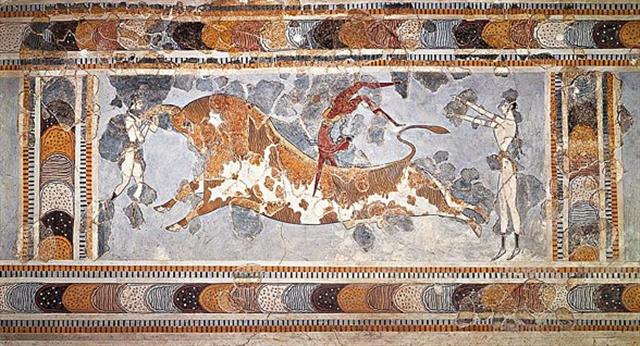 |
In other
words, there were 63 days from day 400
to December 31 (corresponding to July 1
on Easter Island):
 |
 |
 |
 |
|
Cb1-12 (354 + 50) |
Cb1-13 |
Cb1-14 (350 + 8 * 7) |
Cb1-15 (407) |
|
manu rere - kua rere ga manu
- ki te ragi |
eaha te nuku erua |
koia kua huki |
e niu tu |
|
400 = 35 + 365 |
401 |
402 |
403 = 407 - 4 |
|
58 |
 |
 |
 |
 |
 |
|
Cb4-3 (466) |
Cb4-4 |
Cb4-5 |
Cb4-6 (77) |
Cb4-7 |
|
te hakaua |
te henua |
te Rei |
te ua |
kiore - henua |
|
INVISIBLY CLOSE TO THE SUN NORTH OF
THE EQUATOR: |
|
South Dipper-8 (Unicorn)
Φ
Sagittarii
(284.0), μ Cor. Austr. (284.6), η
Cor. Austr.,
θ Pavonis
(284.8)
|
SHELIAK = β Lyrae,
ν Lyrae (285.1), ο Draconis (285.5).
λ Pavonis
(285.7)
ATLAS
(27 Tauri) |
χ Oct.
(286.0),
AIN AL RAMI
(Eye of the Archer)
= ν Sagittarii
(286.2),
υ Draconis (286.4), δ Lyrae (286.3),
κ Pavonis
(286.5),
ALYA = θ Serpentis
(286.6) |
ξ
Sagittarii (287.1),
ω Pavonis
(287.3),
ε Aquilae, ε Cor. Austr.,
SULAPHAT = γ Lyrae
(287.4), λ Lyrae (287.7),
ASCELLA = ζ Sagittarii,
BERED = i
Aquilae (Ant.)
(287.9) |
Al Na'ām-18 (Ostriches) /
Uttara Ashadha-21
NUNKI
= σ Sagittarii
(288.4), ζ Cor. Austr. (288.5),
MANUBRIUM = ο Sagittarii
(288.8), ζ Aquilae (288.9) |
|
SAGITTARIUS: |
|
21 |
Uttara Ashadha
|
ζ and σ Sagittarii |
Elephant tusk, small bed |
Jan 3 (368) |
|
second
of the ashādhā |
NUNKI |
|
|
(*284 = *225 + *59) |
Dec 31 |
Jan 1 |
2 |
3 |
|
CLOSE TO THE FULL MOON
ON EASTER ISLAND: |
|
SIRIUS
= α Canis Majoris
(101.2), ψ5 Aurigae (101.4), ν
Gemini (101.6), ψ6 Aurigae (101.7) |
τ Puppis
(102.2), ψ7 Aurigae (102.4) |
Mash-mashu-sha-Risū-9 (Twins of
the Shepherd)
ψ8 Aurigae (103.2),
ALHENA
= γ Gemini
(103.8), ψ9 Aurigae (103.9) |
ADARA = ε Canis Majoris
(104.8) |
ω Gemini
(105.4),
ALZIRR (The Button) = ξ Gemini
(105.7),
MULIPHEIN = γ Canis Majoris
(105.8),
MEKBUDA (Outstretched) = ζ Gemini
(105.9) |
|
(*101 = *42 + *59) |
July 1 |
2 |
3 |
4 |
|
462 |
463 |
464 |
465 |
466 |
April 29
(119) + 63 = 182 (July 1).

|
